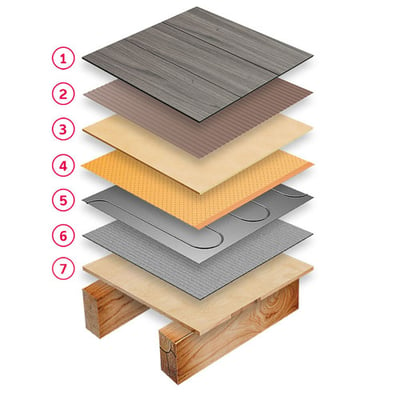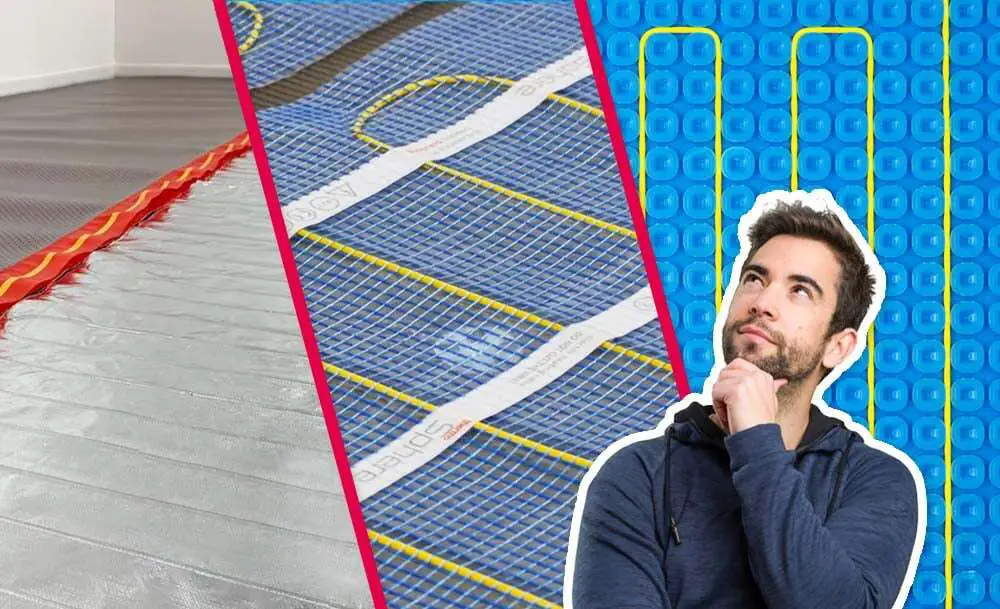7 min read
How thick is underfloor heating?
When looking into installing underfloor heating, ‘how thick is underfloor heating?’ ranks in the top three of the most common questions asked. There...

‘What’s the best underfloor heating for vinyl floors?’ is not an uncommon question we get asked. Vinyl flooring is becoming a more popular floor finish for larger spaces such as an open plan kitchen and dining room. Over the years underfloor heating systems have got better and systems have developed to cater for different floor finishes.
If you are considering installing underfloor heating under a vinyl floor, we’ve collated everything you need to consider before you take the plunge. We’ll be covering some top tips and considerations to help you achieve the perfect installation under your new vinyl floor.
However, if you are short of time and just want to ask a question to one of our experts, you can contact our customer experience team who are always on hand to help. Simply get in touch via our contact page.
Both systems produce radiant heat by heating the floor which means there is a much more even spread of heat compared with traditional central heating radiators so there won’t be any fighting over the warmest part of the room. Just think of the floor as one giant radiator!
Wet underfloor heating
Wet underfloor heating systems are more commonly found in new build projects because they are installed within the construction of the floor. The pipework is installed in a thick layer of screed (between 65mm & 75mm) and the additional load of the system needs to be factored into the design and specification of the boiler. A manifold is connected between the pipework and the heat source (usually a boiler or heat pump), which makes sure that the water is at the right temperature to heat up the floor above via the network of pipes. It’s important that you talk to the manufacturer of your boiler or heat pump to ensure that it is suitable for wet underfloor heating.
Electric underfloor heating
Electric underfloor heating is ideal for renovation projects as well as new builds. There is minimal impact on floor height and it’s fast to install (depending on the size of the room). Electric heating cable is installed underneath the floor level, connected to the mains electricity supply, and controlled with a thermostat. When turned on, the heating cable heats up which warms the surface of the floor, and your desired temperature can be reached within 20-30mins.
It certainly does.
However, different types of vinyl will have slightly different properties. For example, the properties of Karndean, Amtico, Tarkett and Click Vinyl will vary, so it is important that you check the compatibility of the vinyl type for underfloor heating with the flooring manufacturer.
This is particularly important because if temperature thresholds are exceeded then the flooring could get unwanted damage. Generally, the temperature of the underfloor heating system with a vinyl floor finish should not exceed 27°C. This is also another reason we would recommend running a heat loss calculation before any purchase is made. This will help to ensure that you are able to heat the room effectively without overheating the floor.
Moisture
It’s important to be aware of the moisture content of the substrate, before laying the vinyl floor finish. If the moisture content is high, particularly with a concrete substrate, water damage could occur. This can come in the form of ‘bubbling’ of the vinyl, mould appearing and even rips appearing at the seams of Luxury Vinyl Tiles (LVT).
Because most types of vinyl are waterproof, you will only need to worry about moisture under the flooring.
Acclimatising the vinyl
Unlike other floor finishes, vinyl (especially LVT) should be laid flat and allowed to acclimatise to the room at least 24 hours before it is installed. The underfloor heating system should have also been tested twice before the vinyl is installed. Once when you first get it out of the box (if using an electric underfloor heating system) and a second time when the system has been installed. There is also a third test but do this after the vinyl has been laid. It is important that you only turn the underfloor heating system on 48 hours after the vinyl has been laid. This will allow the floor finish to bond correctly and therefore last longer.
If you want to learn more about how to test electric underfloor heating, read the blog article or checkout our YouTube channel.
When installing a vinyl floor, it is important that you add a layer of support above the electric heating system by installing a layer of either HDF or cement overly boards. Why? The vinyl is not strong enough to rest directly on the heating cable and because vinyl is usually stuck down with adhesive, it needs a smooth surface to be installed on.
As mentioned earlier, both wet and electric underfloor heating systems work well with vinyl and which one you choose will highly depend on if it is a new build or retrofit project. As we are electric heating specialists, we’ll focus on electric systems.
Foil electric underfloor heating systems tend to be the ‘go to’ for vinyl floor finishes. With this system, the heating cable is wrapped by two layers of foil which provides great thermal conductivity and fast heat up times. There are a variety of systems you can choose from Warm Up’s Foil Heater system to our very own ThermoSphere Foil. These systems may look similar but there are subtle differences which make the efficiency and practicality of different systems better than others. This could include accessible cable loops for faster installation and if the heating mat is fully earthed.
 |
1. Vinyl tiles 2. Acrylic adhesive 3. HDF overlay 4. Cushioning overlay 5. Foil 6. Cushioning underlay 7. Timber substrate |
Even though removing insulation board will reduce the height of the floor build-up, we never recommend doing it. By removing insulation boards, up to 50% of the heat generated by the heating system will get lost through the subfloor. That’s heat the homeowner is paying for and not enjoying.
Insulation boards come in different thicknesses and types. For concrete subfloors use uncoated boards and for timber subfloors use coated insulation boards. By including them, you’ll help to increase the efficiency of your electric underfloor heating system by up to 50%!
The best underfloor heating system to use with vinyl floor finishes is a foil system. To get the most efficiency out of your electric underfloor heating system, don’t scrimp on insulation, because it will cost more to run and with energy prices increasing, that won’t be a good thing for the homeowner.
If you have any questions about your electric heating, please contact our team who are always on hand with helpful advice that can save you both time and money.

7 min read
When looking into installing underfloor heating, ‘how thick is underfloor heating?’ ranks in the top three of the most common questions asked. There...

9 min read
When you ask a group of people if electric underfloor heating can be used as a primary heat source, more often than not you’ll get a mix of...

14 min read
So, you’ve completed your research on electric underfloor heating and have decided that it’s the perfect fit for your project. But, with so much...